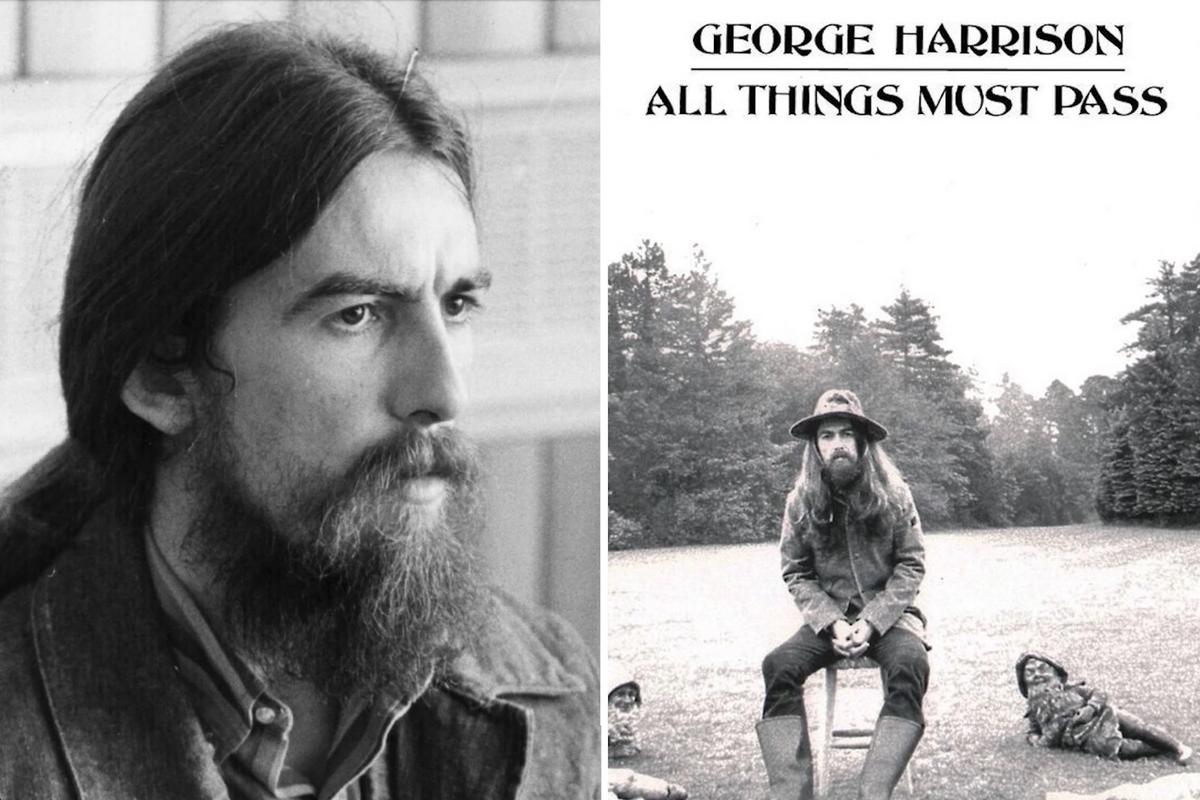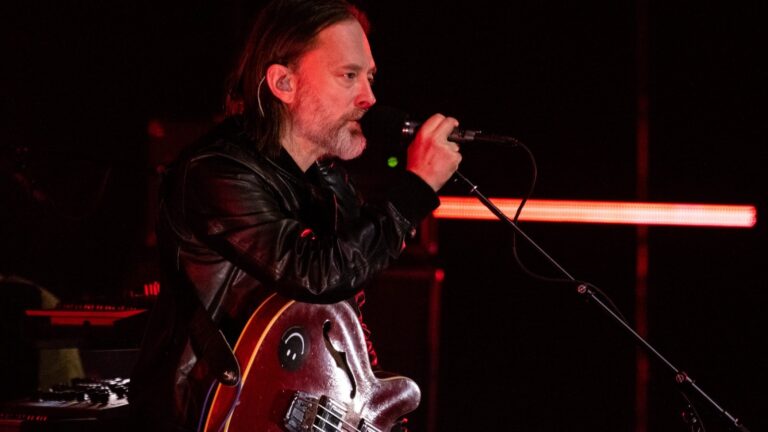George Harrison began his post-Beatles era with a very big bang: All Things Must Pass arrived in the U.S. on Nov. 27, 1970, as a triple-album boasting more than 20 songs. Tucked inside were a couple of huge hits but also a few misses.
Some of the tracks had been saved up as Beatles albums were dominated by the dominant partnership of John Lennon and Paul McCartney. Others were sparked by the group’s ugly end and by Harrison’s personal faith journey. A few were just jam sessions.
They combined to create a definitive musical statement, warts and all. All Things Must Pass would sell more than McCartney’s Ram and Lennon’s Imagine combined. Harrison became the first solo member of the Beatles to simultaneously top both the album and singles charts.
READ MORE: George Harrison’s Best Beatles Moments
He remained the only one until McCartney finally joined him in the summer of 1973 with “My Love” and Red Rose Speedway. (Ironically, McCartney was then replaced at No. 1 by Harrison’s “Give Me Love [Give Me Peace on Earth]” and Living in the Material World.)
Who Played on George Harrison’s ‘All Things Must Pass’?
All Things Must Pass came together organically. Harrison had added guitar to Lennon’s first post-Beatles solo album, 1970’s Plastic Ono Band, where he met future All Things Must Pass producer Phil Spector. Harrison had produced Billy Preston’s Encouraging Words, which featured early covers of “All Things Must Pass” and “My Sweet Lord.”
The sessions that followed included old friends and musical companions like Ringo Starr, Eric Clapton, members of Badfinger and Klaus Voormann. Time spent with Bob Dylan provided some new material. An embryonic new band called Derek and the Dominoes also emerged from the completed album.
It was a lot. The Top 10 smash “What Is Life” followed Harrison’s platinum-selling “My Sweet Lord,” but not every moment on the sprawling All Things Must Pass rose to the level of the album’s biggest singles. Here’s a look back at George Harrison’s ‘All Things Must Pass’ Songs Ranked Worst to Best:
No. 23. “It’s Johnny’s Birthday”
All Things Must Pass ends with a whimper, as Harrison simply noodles around with his extraordinarily talented cast of sidemen. The worst of them is “It’s Johnny’s Birthday,” a goofy send up for John Lennon that somehow became the last thing recorded for this heralded triple album. It gets worse: In an echo of the legal problems surrounding this album’s chart-topping hit “All Things Must Pass,” Harrison was sued over composer credits because of a similarity to Cliff Richard’s 1968 single “Congratulations.”
No. 22. “Plug Me In”
These rest of these jams are meandering, musically pointless filler material …
No. 21. “Out of the Blue”
… and they’re really unworthy of concluding such an important album …
No. 20. “Thanks for the Pepperoni”
… with the only saving grace being this half-chuckle of a title …
No. 19. “I Remember Jeep”
… and the fact that sidemen from these sessions went on to record Layla and Other Assorted Love Songs.
No. 18. “Art of Dying”
Turns out not every studio capture on a massive three-disc, 23-track explosion of a debut album is going to be a winner either.
No. 17. “Hear Me Lord”
Harrison tried to dress up his latest sermon with all manner of studio, musical and even rhythmic tricks. “Hear Me Lord” gets big – really big – but ultimately doesn’t signify much.
No. 16. “Wah-Wah”
Harrison wrote “Wah-Wah” on the day he briefly walked out of an unhappy Beatles recording date, and it shows: This is the grittiest thing on All Things Must Pass. But it’s more than another snippy put-down song. “Wah-Wah” also emerged as an article of solo faith: “I know how sweet life can be,” Harrison cries out from the din, “so I’ll keep myself free.”
No. 15. “I Dig Love”
It’s a weird song. Maybe it’s not even a song at all. But then what would overstuffed multi-disc studio projects be without them? (While pondering, note Ringo Starr‘s crazy fills!)
No. 14. “Apple Scruffs”
Written in tribute to the die-hards who would camp out at the Apple building or various studios hoping for a chance meeting with the Beatles, but curiously played in the coffeehouse style favored by Dylan in his pre-electric days.
No. 13. “Awaiting on You All”
John “How Do You Sleep?” Lennon didn’t have a monopoly on tipping over sacred cows – or taking potshots at his former bandmates.
No. 12. “If Not For You”
A cover from Bob Dylan’s New Morning album, “If Not For You” became another intimate, atmospheric aside that nicely counterbalanced the excesses found elsewhere on All Things Must Pass. Alan White, who played drums during the sessions, said Lennon provided some uncredited guitar work. Later it was basically ruined by Olivia Newton-John.
No. 11. “Isn’t It a Pity (Version Two)”
Harrison’s second version of “Isn’t It a Pity” followed its original contours as a rejected demo for the Beatles, with Phil Spector’s epic production touches replaced by a more intimate atmosphere that allowed Eric Clapton’s guitar to move closer to the listener. The appearance of the Leslie recalled sessions for Abbey Road, too.
No. 10. “Ballad of Sir Frankie Crisp (Let It Roll)”
Harrison takes us along on a travelogue through the mystical, humorous and quite charming Friar Park, the Victorian Gothic mansion in Henley-on-Thames once owned by Crisp.
No. 9. “Behind That Locked Door”
Originally aimed at Dylan, as he planned a huge comeback appearance with the Band at the Isle of Wight Festival, “Behind That Locked Door” became a stirring message of encouragement that we all can use from time to time.
No. 8. “Run of the Mill”
The emotional toll of the Beatles’ troubles was writ large during a song Harrison initially composed before they reassembled for Abbey Road. Spector actually allowed for a rootsy, Band-like structure in a moment of surprising restraint later underscored when one of Harrison’s initial run-throughs appeared on 2012’s Early Takes Vol. 1. Spector didn’t add much; he didn’t have to.
No. 7. “I’d Have You Anytime”
Every bit as moving as Abbey Road triumphs like “Something,” with a Beatle-ish guitar signature and lyrical assist by Bob Dylan. What a gutsy opening song for such an enormous undertaking.
No. 6. “All Things Must Pass”
Harrison initially gave “All Things Must Pass” to Billy Preston when the Beatles rejected it. By the time Preston’s version arrived in September 1970, Harrison had thankfully decided to reclaim this track. Like “Run of the Mill,” his subsequent update was influenced by the the Band’s recent Music From Big Pink.
No. 5. “Let It Down”
Look at Harrison, establishing the loud/soft approach that would define alternative rock back when all of those flannel-wearing guys were still twinkles in their pop’s eyes.
No. 4. “My Sweet Lord”
Docked a few spots because he lost that court case. An American publishing company famously won a $600,000 judgment after claiming that “My Sweet Lord” sounded too much like the early ’60s hit “He’s So Fine.” The court ruled that Harrison “subconsciously plagiarized” the song. Oddly, Harrison countered that he had, in fact, stolen it – but not from the Chiffons. Instead, he said it was originally inspired by Edwin Hawkins Singers’ “Oh Happy Day.”
No. 3. “Isn’t It a Pity (Version One)”
Harrison wouldn’t give up on this one. “Isn’t It a Pity” was notably tried during January 1969 Beatles sessions under the not-very-intriguing title of “George’s Demo.” (Perhaps unsurprisingly, it went nowhere.) At that point, he’d apparently been fooling around with some form of this song since the Revolver period. When he finally got a chance to record it, Harrison paired the frankly titanic first version of “Isn’t It a Pity” with “My Sweet Lord” to create his double A-side debut solo single.
No. 2. “Beware of Darkness”
“Beware of Darkness” originally opened Side Three of Harrison’s post-Fab creative outburst, capturing both the mood and the moment in a reserved, and very Harrison-esque manner. It’s a showcase for his fellow musicians, as sessions evolved into loose amalgams overseen by the mercurial Spector. Yet, Harrison remains the center point, as he matches a lyrical meditation on overcoming life’s harder moments (he simply refuses to give into “the pain that often lingers“) with an arrangement that might draw this album’s clearest line back to the Beatles.
No. 1. “What Is Life”
This towering rocker actually warranted Spector’s Wall of Sound approach. He ended up assembling a who’s-who session: Badfinger added extra layers to a sweeping exclamation of passion, while the background vocals were credited to the George O’Hara-Smith singers — Bobby Whitlock and Clapton, the future nucleus of Derek and the Dominos. Predictably, the results couldn’t be more widescreen – and yet “What Is Life” never loses its sense of intimate joy.
Beatles Solo Albums Ranked
Included are albums that still feel like time-stamped baubles and others that have only grown in estimation.
Gallery Credit: Nick DeRiso
See the Beatles in Rock’s Craziest Conspiracy Theories



